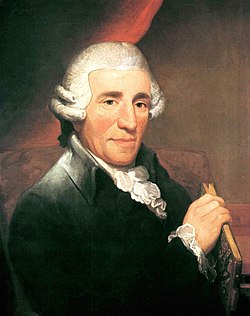Movements
The work is in four movements and is scored for 2 oboes, bassoon, 2 horns, 2 trumpets, timpani, strings and continuo. [4]
- Allegro molto, 2
4 - Menuet in C major and Trio in C minor, 3
4 - Adagio ma non troppo, 2
4 F major - Finale: Presto, 3
8
The work is one of the few symphonies of the Classical era to place the Minuet second (others include Haydn's 37th and 44th, and his brother Michael's 15th and 16th). The winds are dismissed for the slow movement. The 3
8 time signature for the finale is consistent with an early date of its composition. [5]
This page is based on this
Wikipedia article Text is available under the
CC BY-SA 4.0 license; additional terms may apply.
Images, videos and audio are available under their respective licenses.
